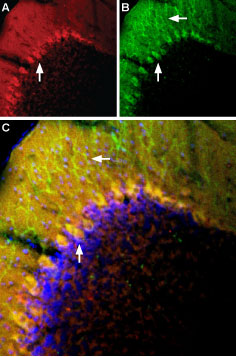Overview
- Peptide HKLSEKLNPSVLRC, corresponding to amino acid residues 822-835 of mouse TRPC3 (Accession Q9QZC1). Intracellular, C-terminus.
- Rat dorsal root ganglion (DRG) frozen section and cerebellum (1:50).
 Expression of TRPC3 in rat DRGImmunohistochemical staining of rat dorsal root ganglion (DRG) frozen sections using Anti-TRPC3-ATTO Fluor-594 Antibody (#ACC-016-AR), (1:50). Staining is present in neuronal cell bodies. Hoechst 33342 is used as the counterstain.
Expression of TRPC3 in rat DRGImmunohistochemical staining of rat dorsal root ganglion (DRG) frozen sections using Anti-TRPC3-ATTO Fluor-594 Antibody (#ACC-016-AR), (1:50). Staining is present in neuronal cell bodies. Hoechst 33342 is used as the counterstain.
The Transient Receptor Potential (TRP) superfamily is one of the largest ion channel family and consists of diverse groups of proteins. In mammals about 28 genes encode the TRP ion channel subunits. The mammalian TRP superfamily comprises six subfamilies known as the TRPC (canonical), TRPV (vanilloid), TRPM (melastatin), TRPML (mucolipins), TRPP (polycystin) and the TRPA (ANKTM1) ion channels.1-4
The TRPC subfamily consists of seven proteins named TRPC1 to 7 which can be further divided into four subgroups based on their sequence homology and functional similarities: TRPC1; TRPC4 and TRPC5; TRPC3, TRPC6, TRPC7 and TRPC2.2,5 They are highly expressed in the central nervous system and to a lesser extent in peripheral tissues.
TRPC3, TRPC6 and TRPC7 form non-selective cationic channels that are activated by the stimulation of GPCRs.
TRPC3 was shown to be activated by DAG and SOC, in heterologous expression systems.6,7
Application key:
Species reactivity key:

Multiplex staining of mGluR1 and TRPC3 in mouse cerebellumImmunohistochemical staining of perfusion-fixed frozen mouse cerebellum sections using Anti-TRPC3-ATTO Fluor-594 Antibody (#ACC-016-AR), (1:60) and Anti-mGluR1 (extracellular)-ATTO Fluor-488 Antibody (#AGC-006-AG), (1:60). A. TRPC3 staining (red). B. mGluR1 staining (green). C. Merge of the two images suggests extensive co-localization in Purkinje cells (vertical arrows). Note expression of mGluR1 in Purkinje dendrites (horizontal arrow) but not of TRPC3. Cell nuclei are stained with DAPI (blue).
